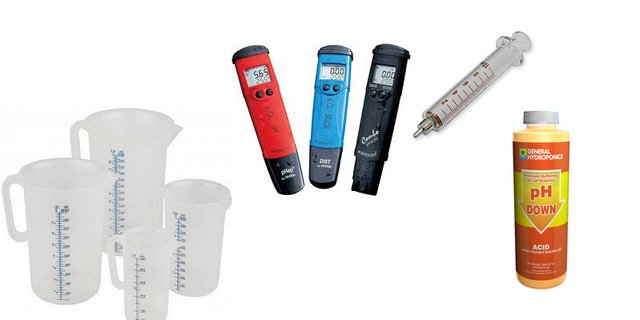How to pH Feeding Solution for Marijuana
In this article I’ll be referring to water or nutrient solution simply as “feeding solution” because, in soil or when flushing, you will still need to pH the pure or nearly pure water you will be feeding to your plants.

What do we need to pH our feeding solution?
You will want some kind of container to put your water in depending on how much you are mixing. If just watering a small handful of plants, empty milk jugs work well. Or if you are watering many plants in a multi-light grow, you can go buy a tough trash can from a home improvement store. Just get the appropriate size for how much feeding solution you mix at once.
Next you will need some sort of pH-measuring tool, whether that is a digital pH pen or pH drops/test strips. I went into more detail on this and gave my personal recommendation in my article on common pH questions.
The next and last things you will need are materials to raise and lower your pH. These can be bought online or at a hydroponic store. There are a variety of products and brands that do this, but generally they will always have a “pH Up” and a “pH Down” bottle in the kit. They don’t cost much, 5-20$ depending on the quantity you are buying.
If money or availability are an issue, you can substitute household white vinegar as a pH Down component (acidic) and regular baking soda for pH Up (basic). I just used these for the first few years I grew, and they worked fine.
The pH Up and pH Down solutions you can buy from the store will, in my opinion, make getting the pH you want a little easier. In my experience, they don’t seem to be as strong as vinegar and baking soda, so you won’t overshoot your target as easily. In hydro systems, as the feeding solution circulates through the plant roots, I’ve noticed the pH remains more stable for a longer period than if you use vinegar and baking soda.
How to actually pH the feeding solution
First, you want to fill whatever container you are using to mix nutrients with the purest water you can. In a later article I will be getting into water quality, but for now this isn’t a big issue for us.
If you are mixing in any nutrients, you want to go ahead and do that next, since that will change the pH of the solution. After you have your nutrients mixed in is when we will start moving the pH up or down towards what we want.
The more feeding solution you have mixed, the more pH Up or pH Down you will need.
If mixing one gallon at a time, then add less than a teaspoon at first. You will want to add pH Down (vinegar) if you need the pH to decrease and pH Up (baking soda) if you need it to increase. Add a very small amount. Then mix the solution thoroughly, and check the pH again. Repeat this process until you get close to your ultimate goal for your pH.
A set of measuring spoons like this can come in handy.
If you are mixing a 20 gallon trash can worth of feeding solution, then you will be needing more pH Up or Down. Start with one tablespoon at a time, and move up from there. The more you do this, the better you will get at estimating how much adjustment your water will need. One of the main tips here is to always start with less adjustment fluid than you think you need – you don’t want to overshoot your target pH by a large margin.
Some extra pH advice…
As I just said, you don’t want to have to add pH Down right after adding pH Up and so on because you continuously overshoot your ideal pH. This can cause the solution to become “buffered” if you have to try to correct it repeatedly. This means that by adding more and more adjustment fluid, you will start to see the pH change less and less until it gets unrealistic to continue with that mixture.
If you find yourself doing this often, then you should cut the amount of pH adjustment fluid you are using when you first add it in by at least ? if not ?. If you get your solution buffered to where you are really noticing the pH resisting change, then I would personally just pour that out and start over.
Obviously, if you are mixing 50 gallons and just added all your nutrients in, that makes it harder to just pour it out. But in reality, whatever those nutrients cost is just a drop in the bucket. It isn’t worth the risk to your plants to feed them defective solutions.
Conclusion
After reading this short article, you should be able to pH your feeding solution quickly and easily. The more you do, it the easier it will get until it is second nature.